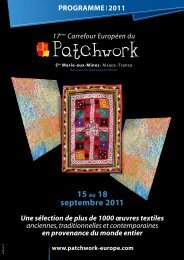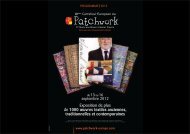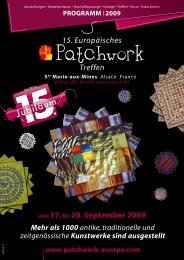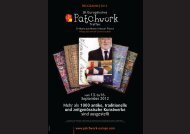Mehr als 1000 antike, traditionelle und ... - Patchwork Europe
Mehr als 1000 antike, traditionelle und ... - Patchwork Europe
Mehr als 1000 antike, traditionelle und ... - Patchwork Europe
Sie wollen auch ein ePaper? Erhöhen Sie die Reichweite Ihrer Titel.
YUMPU macht aus Druck-PDFs automatisch weboptimierte ePaper, die Google liebt.
Donnerstag, 16. September 2010<br />
> Kurs Nr. 4:<br />
Drei Möglichkeiten Ihr Maschinenquilting<br />
interessanter zu gestalten<br />
Rita Berghuis-Ensing (Holland)<br />
Zeitgenössisch – Quilting<br />
Preis: 75 € • 6St. – F, E, D, NL –<br />
Alle Stufen – Maschine<br />
Ton in Ton arbeiten. Sie werden ein einfaches Stück<br />
Stoff mit Strick- oder Effectgarn (Mohair oder ähnliches) verändern<br />
<strong>und</strong> werden die Oberfläche hervorheben. Sie werden die Möglichkeit<br />
haben, Ihre Kenntnisse in freiem Maschinenquilten zu erweitern. Sie<br />
werden eine schöne textile Arbeit Ton in Ton gestalten. Zuerst werden<br />
Sie mit freiem Maschinenstickerei anfangen. Danach werden Sie eine<br />
neue, moderne Methode des Trapuntos entdecken. Das Verwenden<br />
von Garnen während des Maschinenquiltens wird Ihrer Arbeit eine<br />
zusätzliche Note geben.<br />
Gr<strong>und</strong>material: 1, 3, 4, 7, 8, 12, 13, 14, 15, 20, 21<br />
Stoffe: 70x70cm Rückseitenstoff, 70x70cm Baumwollvlies (2x) 70x70cm heller Stoff<br />
für den Top, 100 x 45cm wasserlöslicher Vlies.<br />
Sonstiges: Welche Strickgarnreste passend zu den Stoff, Stickring Madeira 17-18cm,<br />
(keinen Holzerne).<br />
> Kurs Nr. 5 :<br />
Beautiful Gro<strong>und</strong>s:<br />
Paint & Print for Art Fabrics<br />
Linda Colsh (Belgium)<br />
Contemporary – surface design<br />
Price: 75 € • 6 h – F, E – all levels<br />
Starting with plain cloth in this TECHNIQUE<br />
class, students explore different ways to<br />
make textured fabrics for use alone or as backgro<strong>und</strong>s<br />
for layered surface design. Among the techniques are: brushpainting,<br />
monoprinting, colorwash, wine-bottle shibori… Optional,<br />
if time permits: original “fo<strong>und</strong> object” printing will be presented.<br />
Composition, design and positive-negative (Notan) principles will be<br />
taught as part of the creative process.<br />
Students will take home a library of new ideas about layering surface<br />
design on fabric, along with a stash of self-made, unique art fabric.<br />
Basic supplies: 7, 8, 9, 10, 12, 13, 15, 16, 18, 20, 21, 22, 23, 25.<br />
Fabrics to bring: 4 meters minimum white solid 100% cotton solid fabric prewashed.<br />
Optional: other solid colors, black, sheer silk or cotton gauze.<br />
Other supplies: acrylic paints in basic colors (red, blue, yellow, black, white), plastic<br />
water sprayer bottle, 1 wine bottle (Bordeaux shape), ball of string, permanent<br />
markers for fabric, objects to print with or roll over (plastic forms, stamps, corrugated<br />
cardboard, 10-15 rubber bands, roll of kitchen cling film, several paint brushes (2+<br />
sponge, wide & fine bristle), Scotch sticky tape, double face sticky tape, plastic pot<br />
for water, Styrofoam veg/fruit trays for mixing paints, sponge roller, plastic spoons,<br />
hair dryer & extension cord, baking paper, for cleanup: paper towels, sponge, apron.<br />
> Kurs Nr. 6 :<br />
True quilts<br />
Dena Crain (Kenya)<br />
Contemporary – Quilt making and finishing<br />
Prix : 75 € • 6 h – F, E – all levels –<br />
machine / hand sewing<br />
Having trouble with crooked, wobbly quilts<br />
that don’t hang straight no matter what you<br />
do? Learn how to stack a quilt and hang it so that won’t<br />
happen to you ever again! Discover a new way to square a quilt by<br />
stacking the layers to the backing; quickly finish the outer edges<br />
BEFORE you quilt with a roll-over binding, and then set a hanger<br />
sleeve that automatically corrects for any hanging error. A fast-paced<br />
and practical workshop on quilt construction and finishing methods,<br />
this class ensures that all your quilts will hang square, flat, smooth and<br />
beautiful!<br />
Basic supplies: 3, 4, 7, 8, 12, 13, 15, 20, 21, 22, 23<br />
Fabrics to bring: fabrics to back, bind and hang the quilt top, preferably in a<br />
coordinated print which may be one of the top fabrics, 1-2 meters (bring plenty) ;<br />
fabric to hang the finished quilt, minimum ¼ meter long x quilt width.<br />
Other supplies: pencil sharpener ; thread snips (optional) ; craft size batting, 6mm<br />
thick, preferably cotton ; decorative threads (optional) ; invisible thread – good<br />
polyester, not cheap nylon (optional) ; tacking gun and tacks, bent safety pins, or<br />
straight pins for securing quilt layers for quilting ; Exacto knife, blade #11, or other<br />
seam ripper (optional) ; tailor’s chalk, soap sliver or other temporary marker ; 1 small<br />
to medium sized quilt top ready for stacking, quilting and binding (no quilting in<br />
class) ; 1 small to medium sized quilt, ready for hanging ; meter stick.<br />
> Kurs Nr. 7 :<br />
Fractured landscapes<br />
Katie Pasquini (United States)<br />
Contemporary<br />
Price: 75 € • 6h – F, E – all levels – machine<br />
Create a beautiful landscape using a photo of<br />
a “special place”. Find your personal, stylized<br />
version of reality. Fractured the finished<br />
drawing to create different shapes for color<br />
choices and add a surrealistic quality. Work<br />
with stabilizer or fo<strong>und</strong>ation, blind machine appliqué,<br />
machine satin/straight quilting in a quilt-a-you-go format. Easy<br />
techniques that create a complex looking landscape.<br />
Basic supplies: 3, 4, 7, 8, 9, 10, 12, 13, 16, 19, 20, 26<br />
Fabrics to bring: bring fabrics that relate to the photograph or picture. Sort your<br />
fabrics into 7 separate steps, step 1 being white and very pale shades and step 7<br />
being black and very dark shades of all of the colors in your photo. Steps 2 through<br />
6 are gradations in-between. Have several fabrics for each color in each step.<br />
Other supplies: compass ; fabric pencils ;; spray starch, ; black Mitchron 01 pen ;<br />
wash cloth ; an 8” x 10” (20 x 25cm) or larger photo of landscape or flower, or a<br />
photo from a magazine, book or calendar, this will be what you will use to create<br />
the landscape drawing part of the quilt. If you can’t gat an 8” x 10” of your photo,<br />
use a good color Xerox to enlarge it, only as a last resort and only if they can do a<br />
good clear reproduction ; 1 poster board – 50 cm large (thin weight cardboard that<br />
is easy to cut with scissors but strong enough to turn the edge for the fabric over).<br />
Kit *: 4 € includes 46cm Sulky Totally Stable ; acetate.<br />
> Kurs Nr. 8 :<br />
Sakura – Cerisiers en fleurs –<br />
expression abstraite en textile<br />
Chiaki Dosho (Japon)<br />
Contemporain – Art quilt, applications directes,<br />
peinture/teinture, dessin à l’encre de Chine<br />
Prix : 85 € • 6h – F – tous niveaux – machine<br />
Les participants aimeront réaliser un projet textile abstrait sous forme<br />
d’un art quilt qu’ils assembleront. Ils appliqueront des petits bouts<br />
de tissus directement sur un fond et les feront tenir uniquement au<br />
point machine libre. Dans la création de votre propre quilt, les tissus<br />
seront utilisés comme des peintures et les points machine comme<br />
les contours de vos motifs. Pour rendre votre travail plus original,<br />
vous apprendrez également à y dessiner à l’encre de Chine. Pour<br />
vous exercer, le professeur aura des kits contenant de vieux tissus de<br />
Kimono japonais et de l’encre de Chine.<br />
Fournitures de base : 4, 7, 8, 13, 15, 21<br />
Tissus : 90x50cm de molleton thermocollant ; 90x50cm de tissu pour le dos ;<br />
30x40cm de 4 à 5 sortes de tissus blancs ; 30x40cm de 3 à 4 sortes de tissus de<br />
couleur ; toute sorte de tissus (soies, cotons, laines, fibres synthétiques). Les tissus<br />
devront être fins, souples, unis ou proches de l’uni (ton sur ton).<br />
Autres fournitures : Un assortiment de fils polyester ou de rayonne pour la<br />
broderie machine. Une centaine d’épingles.<br />
Kit (optionnel) : 48 € contenant des tissus provenant de vieux kimonos en soie et<br />
un stylo d’encre de Chine.<br />
> Kurs Nr. 9 :<br />
Des anneaux de mariage faciles<br />
et rapides et ses variations<br />
Yoko Okamoto (Japon)<br />
Contemporain – appliqué, piécé<br />
Prix : 85 € • 6h – F – tous niveaux<br />
Les anneaux de mariage sont un des motifs<br />
traditionnels les plus populaires. Les participants apprendront<br />
comment les réaliser rapidement, en se servant de l’appareil à faire<br />
du biais ; ils appliqueront ensuite ce biais sur un fond. Ils découvriront<br />
à quel point cette technique est facile et rapide.<br />
Le professeur vous apprendra également comment dessiner des<br />
variations de ce modèle romantique.<br />
Fournitures de base : 1, 3, 4, 7, 8, 9, 11, 12, 13, 14, 15, 20, 21, 22, 23<br />
Tissus: 30x30cm de 1 à 16 tissus différents, largeur totale 112x100cm.<br />
Autres fournitures : un appareil à faire du biais double de 1.2cm de large (type<br />
Clover), un rouleau thermocollant de 1cm de large (type Clover). ). (Ils seront vendus<br />
dans le cours sur demande).<br />
p.13<br />
Die Kurse









